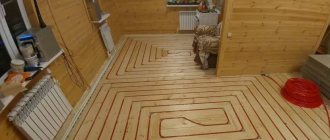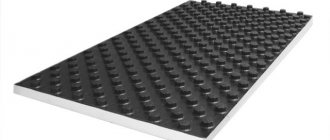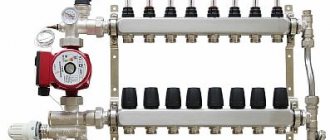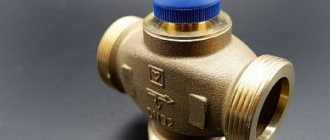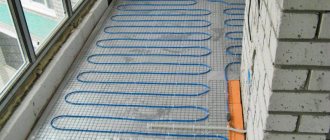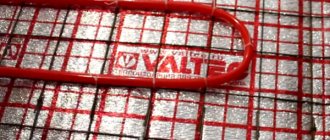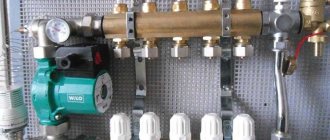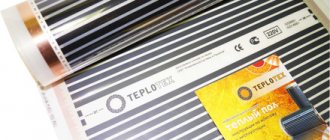In home heating, there is one of the most popular sources, characterized by efficiency and functionality - heated floors. This system was very expensive for quite a long time and available only to wealthy owners of private houses in the suburbs of Moscow or other Russian cities, but now the price has dropped to the middle price segment.
To create a heating circuit inside the floor covering, it is important to secure the pipeline or cable to the base. For this purpose, many fasteners are used: harpoons, mounting tapes and other devices.
One of the effective elements is considered to be an anchor bracket for heated floors. Let's consider the features of using these fasteners, the types of materials used and the rules for choosing brackets.
The use of heated floors in residential buildings
Before fixing brackets for a heated floor, you need to know the operating principle of the heating system. Floor heating is quite expensive and difficult to install, but it can perfectly replace radiator heating. You can make a heating pipeline or cable with your own hands.
The distribution of heat flows throughout the living space when installing heated floors occurs more evenly. The room heats up faster, and the area does not matter - the floor covering acts as a large battery.
Correct installation of the system is the key to the longevity of its operation and the performance of the circuit. Staples for heated floors will allow you to securely and firmly fix pipes or cables to the base.
Types of electric floor
There are three types of electric floors - rod, cable and in the form of infrared films. Only the first two can be considered really popular, partly because the third stands out for its rather high price.
With water heating everything would be much more complicated, because the placement of all the tubes plays an important role there.
- Extension of radiators - step-by-step description and tips on how to add a section quickly and easily (145 photos + video)
- How to make heating with your own hands - diagrams, projects and features of using current heating systems (115 photos)
- Connecting a temperature sensor - automation connection diagram and nuances of use in a heating control system (130 photos, diagrams and video installation)
In the latter case, full-fledged radiators are sometimes very difficult to install, especially depending on the layout of the attic floor and the roof itself, but laying a heated floor that will turn on only when someone uses this room is a great idea.
What are anchor shackles?
To fix pipes on a horizontal surface in a living space, underfloor heating brackets (clips) are used, and they are especially useful on turns or bends.
During installation, the brackets are located at a distance of 50 cm from each other; when turning, this interval is reduced to 10 cm. Compliance with the recommended distance allows you to make the fixation of the pipeline reliable and durable.
The staples are made from a material with increased impact resistance and a special purpose. The fastener design has a spacer, thanks to which the teeth and pipe clamps are installed as tightly as possible. Once the pipeline is secured, it is almost impossible to release it manually.
Specifications
Pipe clips are selected based on diameter.
Anchor clips in the category of fixing devices are classified according to the typical size corresponding to the width of their base fastening. This parameter is decisive when familiarizing yourself with their technical characteristics. According to the existing classification, they are divided into samples of the following type:
- U-shaped brackets of the STK brand, suitable for fastening pipe blanks of various diameters;
- plastic anchor fasteners used for fixing pipes of type “Du 16” in the “water heated floor” system;
- the same products designed for pipe size “DN 20”.
In the practice of installing underfloor heating systems, 16 mm anchor brackets for underfloor heating are especially common; they are optimally suited for attaching polystyrene foam insulating flooring slabs. The dimensions of such a bracket in height are about 51 mm. It contains double hooks in its design, thanks to which the fixed pipe is securely fastened and does not jump out of the insulating material.
Anchor products are suitable for installing underfloor heating from such well-known manufacturers as Uponor, Rehau, KAN and others. The approximate consumption of U-shaped staples of the STK brand is 2 pieces per linear meter. They are made in the form of red clips, which contrast well with the gray plastic pipes.
How to install anchor shackles?
A popular installation option is to fasten underfloor heating with 16 mm staples. Laying with anchor-type fastening devices is carried out in a certain sequence. For example, with polystyrene boards the installation will be as follows:
- The base is cleaned of dirt, dust, and construction debris;
- The surface is leveled, all differences are eliminated;
- A polyethylene film is laid for waterproofing. The layers should overlap the ends of each other, while the joints are tightly taped;
- The surface is laid with standard edge tape;
- Polystyrene mats are laid out, but it is better to allow a slight displacement. Fastening is carried out with special type locks;
- The formation of the contour begins with markings;
- The pipeline is fixed, using brackets for heated floors;
- The structure is covered with gypsum fiber sheets in a couple of layers.
With mounting rails
This mounting option has approximately the same level of complexity as the previous one. To fix the pipes, special clamps are also used, which can not only securely hold the heated floor pipes, but also protect them well from mechanical damage. The use of mounting rails makes it possible to carry out wall mounting without any problems.
However, you should be prepared for the fact that such heating systems are quite rare in stores. Fortunately, Internet resources for selling heating equipment are currently freely available. Marking requires special attention, since it is at this stage that most problems arise. In general, this installation option is convenient and practical.
Alternative options for mounting heated floors
To fix heated floors, not only a bracket is used, but also other devices:
- Mats with bosses do not require additional fastening. They are easy to install and fix, and their thermal insulation qualities are above average;
- Masonry reinforcing mesh for pipelines is fixed with plastic and metal clamps. The design is reliable and highly durable;
- If the base is made of foam plastic, then the pipes are secured with an anchor bracket;
- Concrete base requires perforated tapes during installation;
- Wooden floors are usually heated with pipes installed on wooden modules.
Mats with bosses
Advantages of using mats with bosses:
- You can make a concrete screed directly onto the mats without making a protective layer. Cement does not enter into chemical reactions with mats that have a protective film on the surface;
- Easy installation - modules are assembled by hand;
- Pipe fasteners are not required; the bosses on the plates themselves firmly fix the pipeline;
- The reverse side with a relief increases thermal insulation, noise protection, and also makes it possible to build the system on an unleveled base.
Some polystyrene boards are supplied without bosses, but with markings for the heating circuit.
Reinforcing mesh
The concrete screed can be additionally strengthened with reinforcing masonry mesh. The design becomes several times more durable. To do this, the grid must be laid in a special sequence:
- Clamps made of plastic or silicone make the fastening easy and simple, so the installation of the pipeline will be completed in a few movements. Connections of this type are very reliable and do not break;
- The use of wire limits the installation process - strong tension should not be allowed, since there is a high risk of damage to the pipe;
- An iron clamp is a compromise between plastic clamps and wire. Iron fasteners are more expensive, but the installation process will be lengthy.
Having considered all the options, we can conclude that the installation of the water circuit pipeline is carried out on a reinforcing mesh using plastic clamps.
Advantages and disadvantages
Using a special device, you can quickly secure pipes.
The advantages of anchor brackets include:
- high speed and ease of installation of products in comparison with other methods;
- reliability of fastening of pipe blanks;
- durability;
- relatively low cost.
The fastening element can be used to fix other types of pipelines that are not related to heated floors. Due to the presence of protective plastic teeth, the products in question are highly resistant to impact loads. The disadvantages of fasteners of this class include the complexity of installation on some types of water and electric heated floors.
Foam insulation
In cases where the insulation is made of polystyrene boards, special brackets are used for the water circuit. The bracket is made of plastic, at the end there are teeth in the form of hooks with pointed edges.
Outwardly, its appearance resembles an anchor. The use of staples during installation must be accompanied by accuracy and special care.
The distance between the laid pipes on the foam sheet is calculated, markings are made, after which fastening can be done.
Experts do not recommend removing the bracket and changing its installation location, since the thermal insulation sheet crumbles and becomes of poor quality.
Warm floor. REFLECTOR in the screed or How we are being scammed out of money.
What does the consumer actually pay for when buying a REFLECTOR for a heated floor?
count in dollars, who needs hryvnias anyway)))) just like our Belarusian rubles))))) How many hryvnias were given for a dollar in March 2017?
Happy New Year! How would you “for yourself” attach pipes to polystyrene? The method of using ties to masonry mesh is vehemently criticized on the Internet, and there is logic in it. In this case, all other fastening methods will damage the film (which is between the EPS and the screed). The anchor brackets pierce the film, and the fastening strips are also attached right through. How then to attach it if the film is still pierced by fasteners during the installation process?
My underfloor heating cake is a shiny film - a penpoplex plate - a black film, then a metal-plastic pipe.
Hello Bogdan. The comment is rather belated (2019 is just around the corner), but better late than never. I respect your experience and work very much, but in this case you are not quite correctly interpreting the manufacturer’s recommendations. That is, there is indeed a divorce, but it’s not about the price, but about the material itself. The store actually sells silver-colored film, but in reality there should be aluminum foil on the film. The film has a reinforcing function (for foil) and a protective function for polystyrene, while aluminum is designed not to reflect. (as erroneously interpreted), but to increase the heat transfer area, to make a heat spot out of the thread. Otherwise, we risk getting a zebra effect (depending on the thickness of the screed above the pipe.). I repeat once again, do not take it as a lecture, just a small adjustment. By the way, as I suspected, we are practically fellow countrymen (I’m from Novaya Ushitsa).
Let's chat. My viber is +380982526377
It’s nice to know adequate fellow countrymen. You’re right. But. Show me this film.
The screed was opened; the film was present, but the transparent reflector had already eaten up the cement.
Great, I’ll say more, cement screed does not have any harmful effects on polystyrene. for example. polystyrene concrete blocks. The film is needed only to prevent the solution from flowing and lifting the insulation. so just insulation and screed and that’s it!
let the experts tell you about everything else, but I have a question for you: why the hell hide it. styrene from the screed (black film), if all adhesives for screed are made on a cement base (the same puddle environment)
+Bogdan Khmelnitsky Film only to cover the seams of the insulation. If the seams are foamed, I think the film is superfluous.
+Vitaly Sadovyi I think that if a polystyrene polymer is exposed to aggressive puddle conditions for 28 days, then its molecules will certainly begin to change their structure, not for the better!
unconvincing, even in 45 days nothing will happen to polystyrene, not to mention the fact that classic concrete stands for 28 days, and modern modified screeds even less.
+Vitaly Sadovy Possibly because of time! The time for complete completion of reactions in a cement screed is 45 days. The indicators in adhesive solutions are many times less!
Concrete base
The base of the room is most often made of concrete; the screed is not always covered with a layer of insulation. To fasten pipes to such a base, perforated tapes are used, the structure of which has special recesses for laying pipes.
The profile on a concrete base is fixed with self-tapping screws, the heating elements are installed with special fastening bars. The pipe can be secured to concrete using clips for the water circuit.
A plastic clip is installed to the concrete using self-tapping screws, and a pipe is placed on top of the structure.
For a diameter of 16 mm, staples are chosen with a larger size, and the arcs for connection are cut off. The pipe may wobble slightly when fixed, which is acceptable given thermal expansion.
On the reinforcing mesh
The pipes are loosely fixed to the mesh, maintaining a distance of several centimeters. Special clamps are used as fasteners. The installation step of the brackets is approximately one per 1.5 meters. At least three clamps are installed in rotating areas from 90 degrees. This allows you to ensure reliable fastening, because in this case, it is necessary to overcome the force of metal-plastic pipes to straighten.
The advantage of this simple and reliable method is the availability of fasteners: if necessary, they can be purchased at any specialized store or market. The disadvantages usually include the complexity of installation activities. Particular care should be taken with popular metal-plastic pipes to prevent damage to them when installing brackets for securing underfloor heating pipes.
Insulation on wooden joists
The heating system for floor coverings made of wood requires installation on wooden modules. Each module is placed on logs, so the water circuit is always on top of the insulation.
The pipes are fastened into special grooves, so the installer does not have to think about how to form a heating circuit - the distance between adjacent grooves has already been adjusted. Fixation and type of fastening are selected based on the base, which is located under the pipeline. It is important to take into account all the features so as not to complicate the installation processes.
Construction of polyethylene pipe
Reinforcement. Almost all cross-linked polyethylene pipes have a complex multilayer structure.
It could be:
- polypropylene;
- fiberglass;
- aluminium foil;
- perforated aluminum;
- solid aluminum sheet.
The reinforced layer is able to neutralize sudden pressure changes inside the PE-S pipe when used in a hot water or heating system.
The design of cross-linked polyethylene products provides for the presence of a reinforced layer both on the surface of the product and at various depths. If it is necessary to solder two or more pipes, the reinforcing layer is stripped to 1 cm.
Pipes made of cross-linked polyethylene for underfloor heating are practically not reinforced. This material is also called “pure”.
Oxygen barrier. The manufacturer also calls it a “diffusion barrier” or “anti-diffusion protection.” This layer is mandatory for all types of cross-linked polyethylene products.
The reason for its appearance in HDPE pipes is the ability of oxygen molecules to penetrate into the material through a three-dimensional lattice, as a result of which cross-linked polyethylene is slowly but surely destroyed.
The diffusion barrier can also be either inside or outside the pipe.
Mounting methods
There are quite a lot of ways to attach underfloor heating pipelines. Over time, new technologies appear, both means and methods of fastening are improved.
Let's consider the most common of them, which have received the approval of professionals who have been tested by time of operation.
Attaching to reinforcement mesh
In laying a warm pipeline, the reinforcing mesh does not play the role of a reinforcing element, but rather the basis for fastening heating pipes. It is laid on various layers of hydro- and thermal insulation made of expanded polystyrene or polystyrene, and plastic bends are mounted on top, attaching them to the welded mesh using various means.
The following fasteners are used:
Nylon ties, clamps of different lengths. Price from 1 ruble per piece.
Wire fastening connectors made of steel. They tie the pipes to the mesh with a special hook at a distance of 75 cm between the fastening points. The price per piece is approximately 2 rubles.
Plastic swivel clips installed on the mesh. Raise the mesh above the insulation by 0.5-0.8 mm, which better connects the mesh to the screed. The pipe is inserted into the clamp and snaps into place. Price from 5.5 rubles per unit of goods.
Any home craftsman can carry out these methods with his own hands, having made the necessary calculations.
Mounting on mounting rails
Special fixing tires are produced in the form of a plastic track 50 cm long with clip clamps on top. The planks can be connected to each other into a single strip of the required dimensions. They are convenient for laying pipes made of cross-linked polyethylene PEX.
They are attached to the insulation with anchor brackets, and to the concrete floor using dowels. Price from 48 rubles per piece.
Securing the pipe with clamps
In the absence of reinforcing mesh, fastening with staples or metal clamps is used. These mounting parts are attached to the screed with dowels and nails, and to the wooden floor with self-tapping screws.
Fastening with a tucker
The use of a tacker, a device that resembles the principle of operation of a stapler, is becoming increasingly popular among professionals. In sales it is often called that. The tool is designed for fixing pipes to polystyrene foam with anchor clamps. The device is equipped with a magazine bar that can accommodate 100 or more harpoon staples. Design features allow the operator to work without bending over, without putting much effort on his arms and back, significantly increasing the speed of operations.
Previously, the price of the instrument was at least 17-18 thousand rubles; now devices costing from 4 thousand have appeared on sale.
Installation features
As a rule, the length of the pipeline does not exceed 100 meters, which is necessary to create normal pressure in the system and circulate the coolant. In this case, the number of staples required will be about 250 pieces.
It is allowed to install two brackets per meter of water circuit. In this case, it will be possible to ensure reliable fastening of the pipes without damaging the concrete screed.
By securely securing the pipeline, it will be possible to make it as resistant as possible to any mechanical stress that could lead to depressurization of the system and its failure.
In addition, durable clips can protect pipes from deformation during high pressure in the system, which can also lead to coolant leakage and, as a result, expensive repairs.
Without taking care to securely fix the pipes and encountering their damage, you will have to completely or partially dismantle the floor covering and concrete screed, which will always be accompanied by large financial costs and loss of time.
